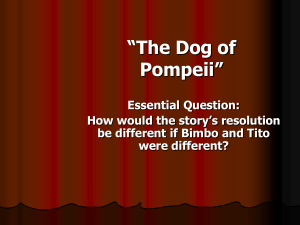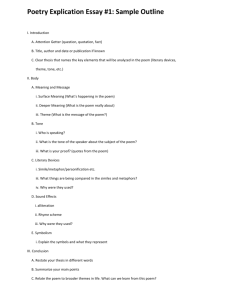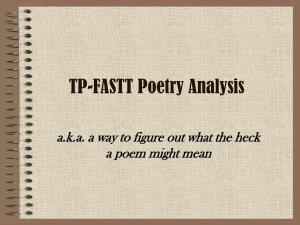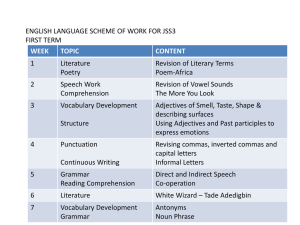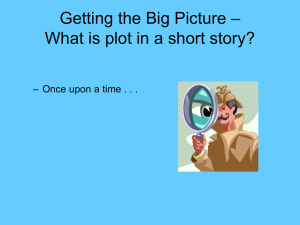TERMS TO KNOW Construction of Literature
advertisement
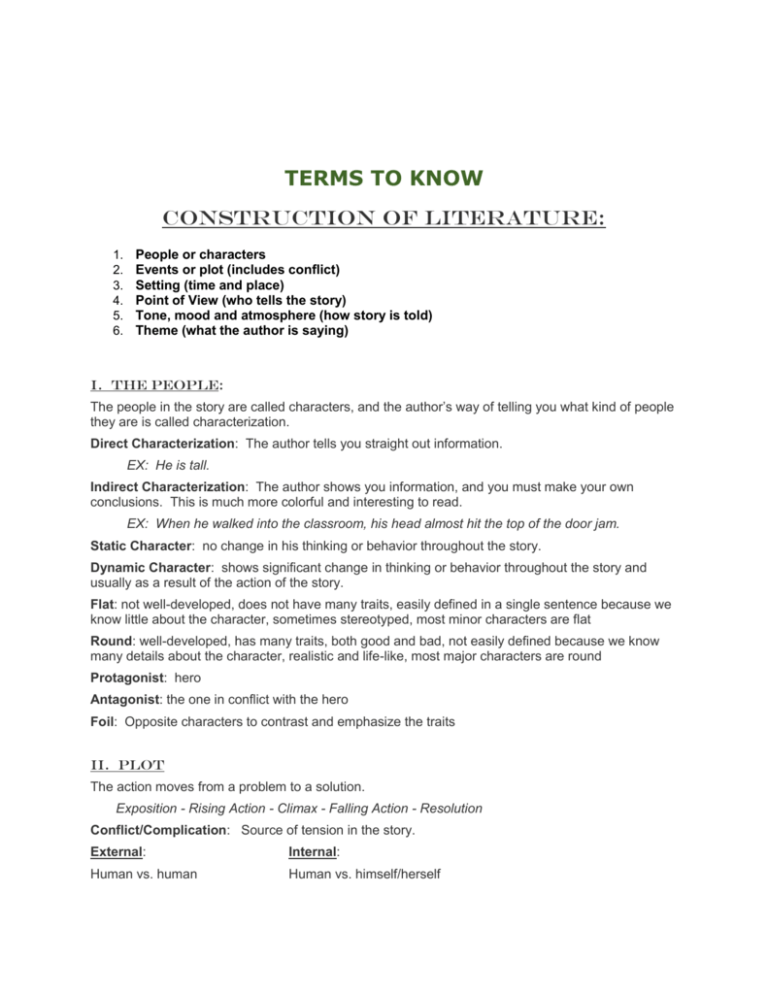
TERMS TO KNOW Construction of Literature: 1. 2. 3. 4. 5. 6. People or characters Events or plot (includes conflict) Setting (time and place) Point of View (who tells the story) Tone, mood and atmosphere (how story is told) Theme (what the author is saying) I. The People: The people in the story are called characters, and the author’s way of telling you what kind of people they are is called characterization. Direct Characterization: The author tells you straight out information. EX: He is tall. Indirect Characterization: The author shows you information, and you must make your own conclusions. This is much more colorful and interesting to read. EX: When he walked into the classroom, his head almost hit the top of the door jam. Static Character: no change in his thinking or behavior throughout the story. Dynamic Character: shows significant change in thinking or behavior throughout the story and usually as a result of the action of the story. Flat: not well-developed, does not have many traits, easily defined in a single sentence because we know little about the character, sometimes stereotyped, most minor characters are flat Round: well-developed, has many traits, both good and bad, not easily defined because we know many details about the character, realistic and life-like, most major characters are round Protagonist: hero Antagonist: the one in conflict with the hero Foil: Opposite characters to contrast and emphasize the traits II. Plot The action moves from a problem to a solution. Exposition - Rising Action - Climax - Falling Action - Resolution Conflict/Complication: Source of tension in the story. External: Internal: Human vs. human Human vs. himself/herself Human vs. nature Human vs. society Human vs. beast or fate Plot Structure: Open base triangle diagram Exposition: characters and setting Inciting incident: first clue to the main problem that leads to the climax Rising Actions: events leading up to the climax Climax: Turning point Falling Actions: specific events after the climax that leads to the resolution Resolution: The outcome of the story III. Setting Time and place. Be specific as possible. IV. Point of View The voice telling the story. First person is the voice used when a character in the story functions as the narrator. Third Person is also known as omniscient (all knowing) and is not a character in the story. This voice has unlimited access to location and thoughts of more than one character. Third Person Limited has limited access to the information and isn’t as common as the other two. V. Tone, Mood, and Atmosphere Tone is the author’s attitude towards what she is presenting. The attitude can be humorous, ironic, sarcastic, loving or spiteful. The author can be sympathetic towards his characters or scornful of them. The attitude shows up in the way he writes about the events and in the event and setting he chooses. Mood is the attitude of the characters towards what is happening. It may be sadness, fear, happiness or one of many others. In some fiction, the mood may change from hope to despair, courage to fear or vice versa. Atmosphere is the general emotional effect of a story or of a scene from a story. It includes the effect of moods and is controlled by the author’s tone. Thus, a story may have an atmosphere of gloom or horror, or of joy or bewilderment, just to name a few. VI. Theme What is the authors’ message to the reader? The theme is usually that message. It can usually be some observation about the human condition-- how the universe treats us, how we treat each other, how we treat ourselves, etc. Some stories may have more than one theme. Another way to define theme is: a particular point of view the author wishes to express about a particular topic (love, death, growing up, nature, relationships, etc.). VII. Other important terms and Figurative Language: A. Poetry Terms:can also be used in novels, short stories, etc. Alliteration: repetition of initial consonant sounds Assonance: repetition of vowel sounds in non rhyming words Blank Verse: unrhymed poetry written in iambic pentameter Cacophony: harsh, discordant mixture of sounds End-stopped line: end of a poetic line with punctuation Epic Simile: extended simile over several lines Epilogue: end of a book which comments on the conclusion Epiphany: moment of sudden revelation or insight Epithet: adjective or descriptive phrase emphasizing the quality characteristic of the person Extended metaphor: comparison over a few lines or an entire work Figurative: meaning beyond the literal Foot: a unit of meter with stressed or unstressed syllables Heroic Couplet: Hyperbole: a gross exaggeration for effect; overstatement Idiom: a form or expression commonly used Iambic: an unstressed syllable followed by a stressed syllable Imagery: descriptions that appeal to one of the 5 senses Literal: exact meaning that the words convey Lyric: poem of a single speaker who expresses his thoughts and feelings Motif: reoccurring idea shown though symbols, action and dialogue. Metaphor: comparison of to unlike things Meter: repetition of a regular rhythmic unit of poetry Monologue: speech by one person where other characters are present Onomatopoeia: a word that imitates a sound Personification: giving inanimate objects human qualities. Poetic form/structure: poem that has a set pattern Prose: no form or structure to the writing Repetition: technique in which a sound, word, phrase or line is repeated for emphasis Rhyme Scheme:: specific pattern of end rhymes in a poem Rhythm: pattern or beat of stressed and unstressed syllables Simile: comparison of two unlike things using like or as Soliloquy: alone on stage character speaks her thoughts to the audience Sonnet: lyric poem of 14 lines, usually in iambic pentameter Speaker: the voice that talks to the readerStanza: group of lines that forms a unit of poetry B. Literary Terms Allusion: a reference to a statement, a person, place or event that is known from literature or history. The most common: The Bible, mythology and Shakespeare. Aside: a remark in a play meant for the audience Cliché: overused phrase that is not original Comic Relief: including a humorous character in a serious work Connotation: the feelings evoked by a word Denotation: definition of a word Diction:word choice Ethical Appeal: making use of what the audience values as true Imply: author gives clues to the reader Infer: reader interprets the clues the author provides Inferences: conclusions based on clues –reader makes these Irony: Irony is essentially a discrepancy between what happens to be and what really is (appearance and reality. There are three types: Situational: Difference between what appears to be and what really is Dramatic: When the audience knows something that the characters don’t Verbal: To say one thing but mean something else (Sarcasm) Exaggeration: emphasize by overstating the truth Flashback: a scene that interrupts the present action of the plot to go back and tell what happened earlier. Foreshadowing: the use of clues to hint at what is going to happen later in the plot. Historical Context: moods, attitudes, and conditions that existed in a certain time and connects to the novel Juxtaposition:two contrasting elements placed side by side Motivation: what drives a character’s actions Non Standard: dialect that may not be grammatically correct Oxymoron: contradictory terms brought together to express a paradox for strong effect. Pun: A play on the multiple meanings of words. Rhetorical Question: asked for effect and not expected to be answered Satire: a style of writing that ridicules human weaknesses, vice or folly in order to bring out social reform. Scene: subdivision is a play Stereotype: widely used, oversimplified idea or image of a person Suspense: causes uncertainty and tension about what will happen in the story Symbol: a symbol is something that stands for itself and for something broader than itself as well. In literature, a symbol may be an object, a person, a situation or an action that suggests or represents a wider meaning. Thing stands for idea. Syntax : words or phrases to create effectively arranged sentences for a particular purpose Tragic Flaw: defect that brings out the or contributes to the downfall Tragic Hero: central dignified or noble character with a defect Understatement: technique to emphasize by saying less than is actually or literally true Vignette: a brief account of something that could be part of a whole, but the whole is not presented. VIII. Literary Genres Comedy: dramatic work with a light and humorous tone Epic: long narrative on a serious subject in a classic or common sense Epic Poem: long narrative poem on a serious subject Essay:brief non-fiction composition Fable: short story conveying emotion Memoir: autobiography with historical events that affect the author Myth: traditional story concerning some supernatural being or unlikely event Narrative: tells a story Narrative Poem:poem that tells a story Nonfiction: about real people and events Novel: extended work of fiction Parable: a simple story that illustrates a lesson Propaganda: biased information presented to publicize a particular point of view Romance: imaginative story relating with noble heroes, chivalric codes of honor, passionate love, daring deeds or supernatural events Tragedy: drama where the actions or events of the main characters end disastrously



